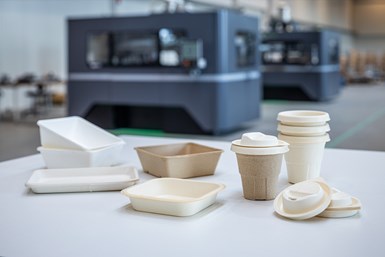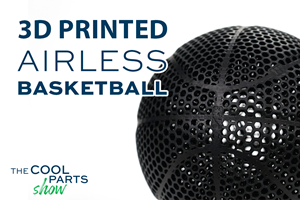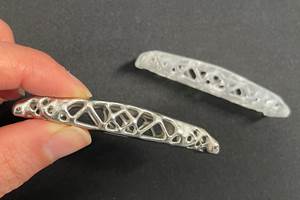ExOne Launches X1 Tooling Industrial-Grade 3D Printed Tooling Solutions
X1 Tooling offers manufacturers fast, affordable and local tooling options for the final production of metal, plastic and composite designs.
Share
Read Next

X1 MetalTool was used to produce tooling for Sweden-based Celwise’s molded fiber products.
The ExOne Co., a global provider of industrial sand and metal 3D printers using binder jetting technology, is launching X1 Tooling, a broad portfolio of industrial-grade 3D printed tooling that includes new solutions for plastic injection molding or forming, laying up composites, casting metals, and more.
The X1 Tooling line is designed to offer tooling options that speed up delivery times and bring tooling closer to the point of final production. Users that 3D print their tooling can help eliminate supply chain issues and make themselves more sustainable, with less shipping and other forms of waste. This fast, flexible tooling portfolio includes six new, affordable tooling applications, the company says.
For plastic production, X1 offers two options: X1 MetalTool is a new 3D printed metal tooling option which has passed preliminary tests to replace standard steel or aluminum tooling for plastic injection molding, blow molding and other plastic forming applications. It is available in 420i (said to be a highly durable and affordable steel-bronze matrix), as well as 316L stainless steel, M2 tool steel and more. This tooling can be finish machined, acid etched and polished to a diamond finish, and is well suited for complex inserts. The second option is X1 ThermoForm which involves a 3D printed sand form infiltrated with a durable resin and coated to create small- to large-format molds for a variety of thermoforming applications, such as vacuum forming, compression molds, foam molding and more.
For composite production, X1 offers X1 Layup and X1 Washout. X1 Layup involves a 3D printed sand form infiltrated with a durable resin and coated for high-precision, high-temperature composite layup applications. It offers dimensional tolerances of ±0.025" and the tooling can be precision machined if needed. X1 Washout is a 3D printed sacrificial tooling that washes out with tap water after traditional layup and autoclaving of composite materials, including carbon fiber. It is a sand form 3D printed with a water-soluble binder and surface coated. It is well suited for ducting, mandrels and other designs with trapped geometries.
For metal production, X1 offers three options: X1 SandCast delivers sand tooling in a variety of sand types and binders, including sustainable inorganic formulas for high-quality aluminum castings. X1 MetalTool, a tool for plastic forming applications, can also be used to directly 3D print end-of-arm tooling, and rugged, perishable or consumable tools in a variety of metals, including tool steels. While still in development, X1 DieMold is used in rugged die molds 3D printed in H13 tool steel and is currently being fast-tracked with several global manufacturers after passing proof-of-concept tests.
All sand- and sand-infiltrated tools are produced using ExOne S-Max series printers with build volume measuring 1,800 × 1,000 × 700 mm (70.9" × 39.4" × 9.84"). X1 MetalTool and X1 DieMold tools are 3D printed in an X1 25Pro with build volume of 400 × 250 × 250 mm (15.75" × 9.84" × 9.84"); development is underway for printing in the larger X1 160Pro.
Related Content
This Drone Bird with 3D Printed Parts Mimics a Peregrine Falcon: The Cool Parts Show #66
The Drone Bird Company has developed aircraft that mimic birds of prey to scare off problem birds. The drones feature 3D printed fuselages made by Parts on Demand from ALM materials.
Read MoreSolving 3D Printing’s Hidden Problem: Vibration
Ulendo’s vibration compensation software can double the speed of FFF 3D printers while maintaining part quality, all without changing the machine’s hardware.
Read MoreAirless Basketball Shows Promise of 3D Printed Lattices: The Cool Parts Show Bonus
Successfully matching the performance of a standard basketball demonstrates the control possible over the mechanical properties of digital materials.
Read MorePossibilities From Electroplating 3D Printed Plastic Parts
Adding layers of nickel or copper to 3D printed polymer can impart desired properties such as electrical conductivity, EMI shielding, abrasion resistance and improved strength — approaching and even exceeding 3D printed metal, according to RePliForm.
Read MoreRead Next
4 Ways the Education and Training Challenge Is Different for Additive Manufacturing
The advance of additive manufacturing means we need more professionals educated in AM technology.
Read MoreHybrid Additive Manufacturing Machine Tools Continue to Make Gains (Includes Video)
The hybrid machine tool is an idea that continues to advance. Two important developments of recent years expand the possibilities for this platform.
Read More3D Printing Brings Sustainability, Accessibility to Glass Manufacturing
Australian startup Maple Glass Printing has developed a process for extruding glass into artwork, lab implements and architectural elements. Along the way, the company has also found more efficient ways of recycling this material.
Read More




















